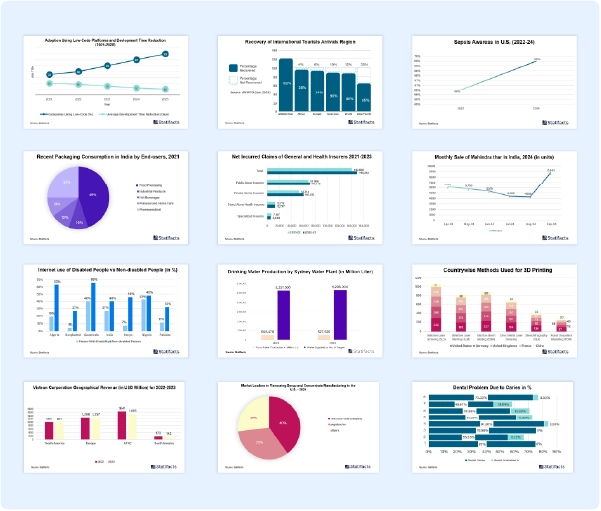The U.S. blood cancer diagnostics market size surpassed USD 4,715 million in 2024 and is predicted to reach around USD 9,276 million by 2034, registering a CAGR of 7% from 2025 to 2034.
U.S. Blood Cancer Diagnostics Market Report Highlights
- By product, the assay kits and reagents segment accounted for the largest revenue share for the U.S. blood cancer diagnostics market in 2024 and are expected to be the fastest growing during the forecast period.
- By product, the instruments segment is anticipated to witness significant growth over the forecast period.
- By end-use, the hospitals and clinics segment dominated with the largest market share in 2024 and is expected to be the fastest growing during the forecast period.
- By end-use, the Diagnostic Labs segment is expected to witness significant growth during the forecast period.
- By test, the blood tests segment dominated the U.S. blood cancer diagnostics market and accounted for the largest share in 2024.
- By test, the molecular test segment is expected to grow at the fastest rate over the forecast period.
The U.S. blood cancer diagnostics market refers to the production, distribution, and application of blood cancer diagnostics, which is immunophenotyping can help diagnose some blood cancers, help specify the exact type of blood cancer, and give a clearer idea of prognosis. Immunophenotyping is normally done on cells collected from a blood test or bone marrow biopsy. Diagnostics procedures for cancer may include genetic testing, surgery, endoscopic examination, tumor biopsy, laboratory tests, and imaging. In the diagnostics of cancer, imaging tests are used, which may include X-ray, ultrasound, positron emission tomography (PET) scan, magnetic resonance imaging (MRI), bone scan, and computerized tomography (CT) scan. Hematology tests include tests on the blood, blood proteins, and blood-producing organs. These tests can evaluate many varieties of blood conditions,s including leukemia, blood clotting disorders, hemophilia, inflammation, anemia, infections, and the body’s response to chemotherapy treatments.
The rising incidences of leukemia and other blood cancers worldwide drive the demand for blood cancer diagnostic tests and technologies. Leukemia is a blood cancer characterized by the rapid multiplication of abnormal white blood cells. This uncontrolled growth takes place in the bone marrow. A diagnosis of leukemia is generally made by analyzing a patient’s blood sample through a complete blood count test and microscopic evaluation of the blood or by using flow cytometry. Flow cytometry blood tests can identify the types of cells in blood or bone marrow. It can also provide important information about the amount of DNA in the cells and how quickly leukemia is spreading. A leukemia diagnosis in the early stages enhances a patient’s prognosis greatly, so it is crucial to be tested as soon as possible if leukemia is suspected. These factors help the growth of the U.S. blood cancer diagnostics market.
Artificial intelligence (AI) benefits for blood cancer diagnostics include extracts of new insights about tumor behavior, predicting patient survival, predicting tumor molecular profiles, and cancer detection. NCI-supported research has shown that AI imaging algorithms enhance breast cancer detection on mammography but can also help predict the long-term risk of invasive breast cancer. A blood test that uses artificial intelligence (AI) to detect cancer-related genetic changes and protein biomarkers could help screen women for early signs of ovarian cancer, according to detect cancer-related genetic changes and protein biomarkers. In hematology, AI-based methods have been applied to automatically detect and classify single-cell images or superordinate patterns from digital microscopy to support the evaluation of flow cytometric data. These factors help the growth of the U.S. blood cancer diagnostics market.
Environmental influences, genetic predispositions, and the rising senior population are leading to an increase in the prevalence of blood cancer, driving the growth of the U.S. blood cancer diagnostics market. Cancer-related genetic changes can occur due to random mistakes in our DNA that happen as our cells multiply. DNA is altered by carcinogens in our environment, like UV rays from the sun, chemicals in tobacco smoke, and the human papillomavirus (HPV), which were inherited from one of our parents. In some cases, blood cancers, including multiple myeloma, lymphoma, myelodysplastic syndrome (MDS), and leukemia, are related to inherited genetic factors. Among these, the genes responsible for inherited forms of acute leukemia and myelodysplastic syndrome are the best characterized. Environmental pollution caused by chemicals in the air, drinking water, food, and workplace may contribute to cancer. The harmful health effects of chemicals can lead to blood cancer, which drives the growth of the market. Early diagnosis is key to our survival efforts, such as an increased range of treatment options, improved long-term survival, and improved quality of life. Aging is the most important risk factor for malignant disease.
Published by
Deepa Pandey

